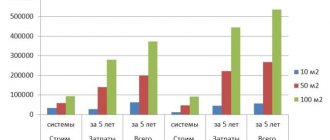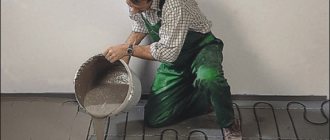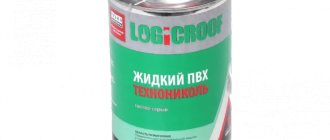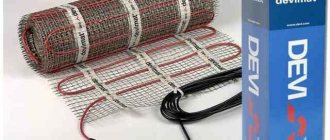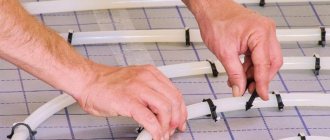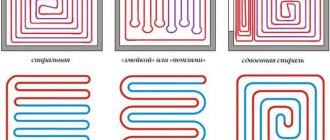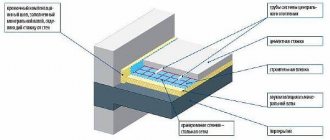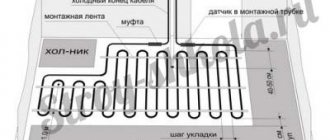- Calculation of heated floors to optimize the operation of the heating system
- Purpose and calculation of floor heating
- Coolant temperature
- Underfloor heating bases
- Calculations of pipes for water heated floors (length, diameter, pitch and installation methods and pipes)
- Floor coverings
- Pumping equipment in underfloor heating calculations
- Calculation of the cost of heated floors
- Video: calculation of heat transfer of a heated floor, method + program
Calculation of heated floors to optimize the operation of the heating system
The calculation of the heat of a heated floor is made taking into account heat loss through the enclosing structures and the usable area of the rooms. Errors in calculations affect the operation of the system, increase energy consumption and the cost of maintaining the house. Errors are due to the use of aggregated indicators. The efficiency of insulation and the tightness of structures (foundation, load-bearing walls, ceilings, roofing, double-glazed windows, entrance doors) guarantees economical consumption of energy resources in a water-heated floor system.
Water heated floor: diagram, photo, technology for installing a heated water floor (read more)
Careful calculation of a heated floor design increases the energy efficiency of the entire heating system and reduces its maintenance costs.
Coolant temperature
The coolant temperature in the circuit depends on the thermal load, laying pitch, pipe diameter, screed thickness and flooring material. The minimum temperature values in the circuit are taken for parquet boards and small-piece wood products. Tiled, metlakh, ceramic tiles, porcelain tiles, marble can withstand the maximum permitted coolant temperature (55°C). Low-pressure heating schemes that are used in practice have an operating range of 45/35°C.
Sanitary standards determine the comfortable (26°C) and permissible temperature limit for the human foot:
- 28°C in living rooms for permanent stays;
- 35°C around the perimeter of the load-bearing walls of a residential building;
- 33°C for kitchens, bathrooms and sanitary rooms.
According to sanitary standards, the temperature of the coolant in the bathroom should be 33 degrees.
Methods for installing pipelines for a water floor
Before installing pipes, you need to plan their location. There are several methods, which are divided into the following forms:
- a snail of two bends;
- snake;
- double snake;
- corner snake.
Snail pipe laying is used in rectangular or square rooms. With this installation, heat is evenly distributed over the entire floor surface.
Snake laying is used for long and small rooms.
Calculation of the amount of pipeline for the heating system will depend on the chosen form of installation.
Underfloor heating bases
The type of overlap affects the materials and the choice of thickness of layers above and below the pipe. The basis for heated floors is cement screeds and flooring systems made of polystyrene or wooden inter-pipe boards. The aluminum profile in slatted modules serves as insulation of wood from direct contact with the heating element and for fastening pipes.
The routing of circuit pipes on concrete floor slabs is arranged in the body of the concrete screed. The volume of material and installation calculations for heated floors are determined after preliminary marking of the surface (hydraulic or laser level). The layout plan is done on paper (scale 1:50). The accuracy with which the calculation is carried out determines the consumption of material and the speed of work.
In the flat version of installing heated floors, the modular slabs have grooves for laying water floor pipes.
The surface, cleaned and treated with a polymer primer, is leveled in advance, and waterproofing is done on the ground and first floors. Cover the walls around the perimeter with damper tape to a height that will go under the screed (with a small margin). Thermal insulation material with a foil base screens the specific heat flux upward in a given direction. Heat loss through the foil does not exceed 5%.
The reinforcement is laid on top of the insulation, the frame gives rigidity to the screed and allows for correct fixation of the step. The pipe circuit is laid out, secured, the circuit is tested under pressure and filled with screed solution.
The warm water floor is installed using special mats.
Lightweight modular systems are used for wooden structures (subfloor or joists) that are not capable of high static loads.
Floor coverings
Types of finishing floor coverings for heated floors: self-leveling surface, linoleum, laminate or parquet, tiles, ceramic and metlakh tiles, marble, granite, basalt and porcelain stoneware.
Wooden flooring is not suitable for constant humidity in the room, so it is not used in bathrooms with heated floors.
Thermal conductivity of floor coverings:
| Material type | Layer thickness δ, m | Density γ, kg/m³ | Thermal conductivity coefficient λ, W/(m °∁) |
| Insulated linoleum | 0,007 | 1600 | 0,29 |
| Tile, metlakh, ceramic | 0,015 | 1800 ÷ 2400 | 1,05 |
| Laminate | 0,008 | 850 | 0,1 |
| Parquet board | 0,015 ÷ 0,025 | 680 | 0,15 |
| Insulation (ursa) | 0,18 | 200 | 0,041 |
| Cement-sand screed | 0,02 | 1800 | 0,76 |
| Reinforced concrete slab | 0,2 | 2500 | 1,92 |
Installation of a water heated floor in a concrete screed with a final covering of tiles.
Pumping equipment in underfloor heating calculations
Reducing the coolant temperature allows for efficient operation of circulation pumps.
The heating circuit of underfloor heating is located on a horizontal plane and covers a large area. The force that the circulation pump imparts to the flow is spent on overcoming linear and local resistance. The calculation of a pump for underfloor heating depends on the diameter, roughness of the pipe, fittings and length of the circuit.
Connection diagram for a heating system with a warm water floor.
The main calculation parameter is the pump performance in the low-pressure circuit:
Н = (П×L + ΣК)/1000 , (m), where
N is the pressure of the circulation pump, m;
P - hydraulic loss per linear meter of length (passport data from the manufacturer), pascal/meter;
L—maximum length of pipes in the circuit, m;
K is the power reserve factor for local resistance.
K = K1 + K2 + K3 , where
K1 - resistance on adapters and tees, connections (1,2);
K2 - resistance on shut-off valves (1.2);
K3 - resistance at the mixing unit in the heating system (1.3).
Pressure characteristics of the circulation pump.
The degree of performance that the circulation pump has is determined by the formula:
G= Q/(1.16 ×∆t) , (m³/hour), where
Q—thermal load of the heating circuit (W);
1.16—specific heat capacity of water (Wh/kgC);
∆t – heat removal in the system (for low-pressure circuits 5 ÷ 10°C).
Manifold cabinet with connected floor heating system.
Dependence of unit power on the area of heated premises (for hydraulic calculation of heated floors):
| Floor area, m² | Circulation pump capacity for heated floors, m³/h | |
| 80 ÷ 120 | 1,5 | |
| 120 ÷ 160 | 2,0 | |
| 160 ÷ 200 | 2,5 | |
| 200 ÷ 240 | 3,0 | |
| 240 ÷ 280 | 4,0 | |
On a note! The power of the unit consists of the sum of the flow rates of all circuits. In case of abnormal cold weather, it is necessary to provide a pump capacity reserve of 15 ÷ 20%.
An example of a scheme for distributing a warm water floor by sector.
What technical parameters are determined when laying a pipeline?
Before laying the floor circuit, a thermal calculation is usually carried out, which takes into account the optimal temperature in the room, heat loss depending on the wall material (thermal conductivity), and the temperature parameters of the coolant in the system. The data obtained helps to calculate the number of pipes for a heated floor, that is, determine their optimal length and diameter. Before installing underfloor heating, a specialist and/or homeowner should consider a number of factors listed below.
Selection of pipeline material
Several types of metal and polymer pipes are optimally suited for laying heated floors; the main requirements for materials are: corrosion resistance, good thermal conductivity, low coefficient of thermal expansion and long service life. When choosing a pipeline material for a heated floor, consider the following varieties:
Copper. Annealed copper pipes have the highest degree of thermal conductivity and high corrosion resistance; their main disadvantage is their high cost. Copper pipes are also difficult to install; when laying them, a pipe bender is needed to bend them; the connection is usually made using gas welding.
Another disadvantage of copper can be the form of release - the standard coil length of 50 m is not always enough to install a heating circuit without butt joints under the screed.
Stainless steel. A corrugated stainless steel pipeline has an acceptable cost with high thermal conductivity, good corrosion resistance and relative ease of installation. Its main disadvantage is the high hydraulic resistance to water flow, associated with the ribbed surface of the internal walls, as well as the not always acceptable quality of metal in a cheap product, which leads over time to wall corrosion and leaks.
Calculation of the cost of heated floors
The gas boiler and the floor hydraulic circuit are connected by a manifold. A uniform flow of coolant is ensured by automatic adjustment using balancing and thermostatic valves. The check valve protects the pumping and mixing unit.
Heated floor components:
| Item name | Size and unit of measurement | Price per unit of goods (RUB) |
| Waterproofing | roll (1.5×50 m) | from 2000 |
| Damper tape | 25 m | from 500 |
| Shielding thermal insulation (expanded polystyrene) | 1100×800×38 mm | 769 |
| Pipe | 16 ÷ 20 mm | 50 ÷ 80 |
| Concrete screed: cement dry mixes | 50 kg 25 kg | 125 200 |
| Collector group assembled | 2 outputs | 4600 |
| Pumping and mixing unit: thermostatic head, balancing and thermostatic valves, circulation pump | set | from 20000 |
The total cost of a heated floor is determined by the area of the room, the equipment, the quality of the material and the method of performing the work. Batch formation of a heated floor ensures compatibility of elements and effective heating in temperature ranges. Factory equipment reduces the cost of materials by 1.5-2 times.
Elements of a combined heating system.
The owner of the house can make calculations for water-heated floors and install the system with his own hands if he has sufficient knowledge in heating engineering, hydraulics, materials science and experience in performing plumbing work. A lot of positive examples from life are inspiring. However, everyone should carry “their own briefcase”; their own home is not a springboard for experiments.
Basic parameters for TP design
The location of heating elements that influence the specific power of a heated floor per 1 m2 is designed based on the thermophysical characteristics of the structure. In this rather complex process, many different factors must be taken into account, including:
- regional thermal standards - minimum outside air temperature in the coldest period of the year;
- the average temperature in each room and their location;
- features of building structures - material and thickness of walls, floors and ceilings or interfloor ceilings;
- the number and type of windows, their total area, heat loss coefficient, which largely depends on the type of double-glazed windows installed;
- positioning of the building relative to the cardinal directions;
- the height of the premises, as well as a number of others.
The proposed list of parameters that influence the calculation of heated floors is far from complete - an experienced heating engineer will indicate a dozen more important thermophysical characteristics.
However, the primary task of such a design is to select such a thermal performance of the TP that is guaranteed to be able to compensate for all the energy losses of the heated building. We must also not forget that it is recommended to increase the calculated theoretical power by 10-15% so that the thermal installation does not operate at the limit of its capabilities.
Regardless of whether the calculation of heated floors is carried out with your own hands or by specialized specialists, in all cases they are based on the requirements of GOST R 55656-2013 “Energy characteristics of buildings. Calculation of energy use for space heating." Below is a simplified method for independently designing a small apartment floor heating installation.
